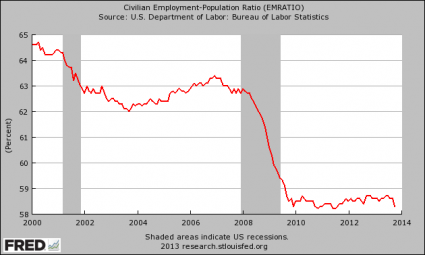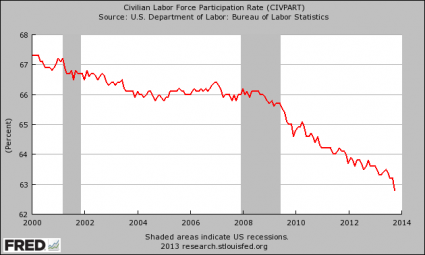Submitted by Michael Snyder of The Economic Collapse blog,
Did you know that there are more than 102 million working age Americans that do not have a job? Yes, I know that number sounds absolutely crazy, but it is true. Right now, there are more than 11 million Americans that are considered to be "officially unemployed", and there are more than 91 million Americans that are not employed and that are considered to be "not in the labor force". When you add those two numbers together, the total is more than 102 million. Overall, the number of working age Americans that do not have a job has increased by about 27 million since the year 2000.
But aren't things getting better? After all, the mainstream media is full of headlines about how "good" the jobs numbers for October were. Sadly, the truth is that the mainstream media is not being straight with the American people. As you will see below, we are in the midst of a long-term unemployment crisis in America, and things got even worse last month.
In this day and age, it is absolutely imperative that people start thinking for themselves. Just because the media tells you that something is true does not mean that it actually is. If unemployment was actually going down, the percentage of the working age population that has a job should actually be going up. As you are about to see, that is simply not the case. The following are 10 facts about the growing unemployment crisis in America that will blow your mind…
#1 The percentage of working age Americans with a job fell to 58.3 percent in October. The lowest that number has been at any point since the year 2000 is 58.2 percent. In other words, there has been absolutely no "jobs recovery". During the last recession, the civilian employment-population ratio dropped from about 63 percent to below 59 percent and it has stayed there for 50 months in a row. Will the percentage of working age Americans with a job soon drop below the 58 percent mark?…
#2 The U.S. economy lost 623,000 full-time jobs last month. But we are being told to believe that the economy is actually getting "better".
#3 The number of American women with a job fell by 357,000 during the month of October.
#4 The average duration of unemployment in October 2013 was nearly three times as long as it was in October 2000.
#5 The number of Americans "not in the labor force" increased by an astounding 932,000 during October. In other words, the Obama administration would have us believe that nearly a million people "disappeared" from the U.S. labor force in a single month.
#6 The number of Americans "not in the labor force" has grown by more than 11 million since Barack Obama first entered the White House.
#7 In October, the U.S. labor force participation rate fell from 63.2 percent to 62.8 percent. It is now the lowest that it has been since 1978. Below is a chart which shows how the labor force participation rate has been steadily declining since the year 2000. How can the economy be "healthy" if the percentage of Americans that are participating in the labor force is continually declining?…
#8 If the labor force participation rate was still at the same level it was at when Barack Obama was elected in 2008, the official unemployment rate would be about 11 percent right now.
#9 Even if you are working, that does not mean that you are able to take care of yourself and your family without any help. In fact, approximately one out of every four part-time workers in America is living below the poverty line.
#10 In January 2000, there were 75 million working age Americans that did not have a job. Today, there are 102 million working age Americans that do not have a job.
So what are our politicians doing to fix this?
Shouldn't they be working night and day to solve this crisis?
After all, Barack Obama once made the following promise to the American people…
"But I want you all to know, I will not rest until anybody who's looking for a job can find one — and I'm not talking about just any job, but good jobs that give every American decent wages and decent benefits and a fair shot at the American Dream."
Unfortunately, things have not improved since Obama made that promise, but he has found the time to play 150 rounds of golf since he has been president.
Meanwhile, because there aren't enough jobs, the number of Americans living in poverty continues to grow.
As I wrote about the other day, according to new numbers that were just released an all-time high 49.7 million Americans are living in poverty.
And right now 1.2 million public school students in the United States are homeless. For many more statistics like this, please see my previous article entitled "29 Incredible Facts Which Prove That Poverty In America Is Absolutely Exploding".
The only thing that most Americans have to offer in the marketplace is their labor. If they can't find a job, they don't have any other way to take care of themselves and their families.
The future of the middle class in America depends upon the creation of good jobs. It really doesn't matter how far the quantitative easing that the Federal Reserve has been doing pumps up the current stock market bubble. The American people were told that "economic stimulus" was the reason for doing all of this reckless money printing, but the percentage of working age Americans with a job is now actually lower than it was four years ago. Quantitative easing has been a complete and total failure in the job creation department, and it is doing a tremendous amount of long-term damage to our financial system.
The really frightening thing is that the Federal Reserve and the federal government have supposedly been doing all they can to try to "create jobs" and they have utterly failed. In fact, this is the first time in the post-World War II era that we have not seen an employment recovery following a recession.
And now the next wave of the economic collapse is rapidly approaching. What that hits us, millions more Americans will lose their jobs.
So the truth is that this is just the beginning of the unemployment crisis in America.
Yes, things are bad now, but soon they will get much worse.
![]()
via Zero Hedge http://feedproxy.google.com/~r/zerohedge/feed/~3/8mlOofVpO5s/story01.htm Tyler Durden





















